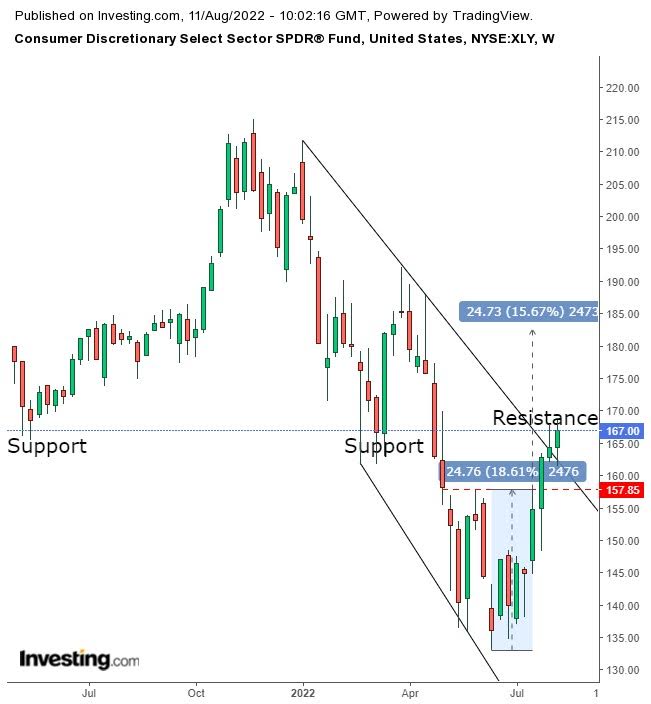The consumer discretionary sector (XLY) has been gaining, even outperforming other industries. This sector includes non-essential goods and services like appliances, cars, and entertainment. The sector is sensitive to the economic cycle; when consumers are confident in their financial future, they splurge on luxury.
The mirror image of this sector is consumer staples—which includes foods and beverages, household goods and hygiene products—as they are always in demand because consumers cannot live without them.
Inflation
In July U.S. inflation eased from a four-decade high to 8.5% as energy prices retreated. The Labor Department reported that overall consumer prices gained 0% monthly in July due to falling gasoline prices.
President Joseph Biden's administration quickly adjusted its focus to this narrow piece of data and touted 'zero inflation.' But really that is like saying that a car driving at a break-neck speed towards a cliff is driving safely just because it has not increased its speed.
Also, the Federal Reserve notoriously discounts food and energy prices from its inflation gauge because they are volatile. But even if the Fed doesn't care about a reduction in inflation due to energy and food prices, the stock market does.
The consumer discretionary sector surged 2.82% yesterday to provide one of the best returns of all of the S&P 500 sectors, only just behind materials, which rose 2.84%. As recession fears eased, traders expected consumers would start buying things other than necessities.
But luxury items didn't just outperform yesterday, they also outperformed on a monthly view, gaining 14.09%, 2.51 percentage points more than the technology sector's 11.58% gain.
XLY, which indicates future confidence, also has enjoyed the best returns on a 3-month basis, up 10.63%, 2.57 percentage points more than the tech sector.
Now, let's gauge supply and demand as presented in the chart.
Bottoms Up

At first, when I looked at this chart, I immediately noticed an Evening Star (encircled in red), a three-day reversal pattern from August 3-5.
On August 6, pricing formed a shooting star, and another, one-day failed advance. Sure enough, it was followed by a decline. However, as already mentioned, the index surged after Biden's 'zero interest rate' comment.
The potency of these back-to-back bearish patterns is limited in the broader supply-demand context as they took place at the top of the falling channel since January.
However, I am conflicted. I also noticed that the ETF completed a bottom. That's bullish and contradictory to my original thesis. But why would there be a bullish pattern? Is the market wrong? What about 'the trend is your friend?'
Then, I thought that perhaps the Fed had lost credibility.
Remember, the Fed denied inflation until it reached its highest level in 42 years. Then, Powell denied a recession at the FOMC press conference on July 27, one day before July's GDP print. As the New York Times put it in the very title of an article: The Fed Won't Say the 'R' Word, with the subheading Chair Jerome Powell was asked in every possible way whether the economy was in, or headed toward, a recession. And every time, he answered: No, not at all.
Finally, the next day, GDP declined for the second quarter, triggering a technical recession. However, Biden rejected outright the possibility of a downturn.
Back to the chart. Perhaps the price's back-to-back bearish patterns at the top of the falling channel following the bottom projects my conflict. Maybe the resistance is a setup for a return move before it continues higher.
Meanwhile, after the initial burst, the volume declined, providing negative divergence. The RSI showed falling momentum, too, parted from rising prices since the star was born (small candle in the middle) in the Evening Star. Finally, the Volume Oscillator showed a substantial negative correlation, plummeting before the bottom's breakout.
Now, let's look at the weekly chart.

Last week produced an imperfect (due to a small lower shadow) shooting star, as the price is finding resistance at the 167 level, which has proved to be a bull-bear boundary since May 2021. So, how to proceed?
Trading Strategies
Conservative traders should wait for the trend to sort itself out.
Moderate traders would go long if the price demonstrates accumulation above the bottom's neckline.
Aggressive traders could short, before joining moderate traders, according to the above criteria.
Trade Sample - Aggressive Short Position
- Entry: $167
- Stop-Loss: $169
- Risk: $2
- Target: $157
- Reward: $10
- Risk-Reward Ratio: 1:5
